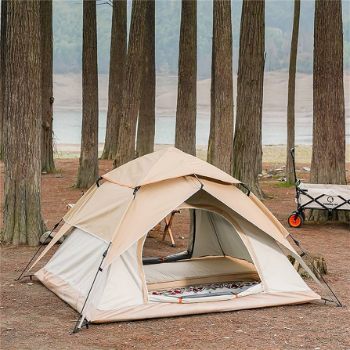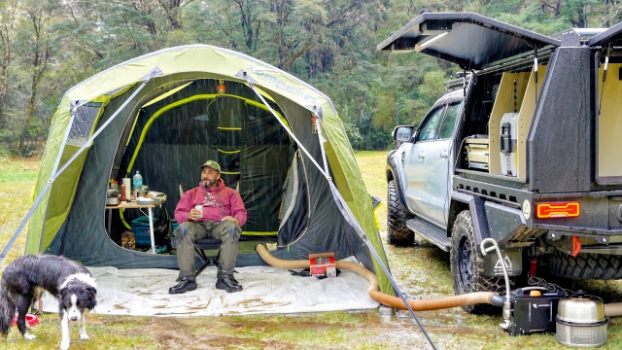Let’s face it: electronics are just a part of our lives now, no matter where we go. Sure, many of us remember the days when going camping meant that you brought a book or some magazines, and for the kids you brought the outdoor games, like a ball and glove, frisbee, hula hoop, or the best one: your imagination! And even today you can do this as well, though it takes a bit more effort to ensure you really stay “unplugged”.
However, there are times when certain electronics just have to be a part of your camping gear. Others might howl at this injustice, but hey, they camp how they want to, and you camp how you want to. And honestly, sometimes these devices are needed for sleeping, medication or any number of other things. In those cases, how do you keep things powered during a weekend, or even longer? In this post, I’ll address the smaller items that don’t draw so much energy. In another post, I’ll address some larger items, especially caps and other big-energy-draw items.

What Do You Mean By “Small Devices”?
I think it’s important to first determine what we mean by “small devices”. While we could create an exhaustive list, that list would quickly get outdated, and its just too much to begin with to list all of the items that would fall into the “small/smaller devices” category. In researching this article, it seems like a fairly common thing to call a “small device” regarding power needs as an item that requires less than 100 watts of power. While this seems like a high wattage, when you get to larger items for powering, it really isn’t.
An example list of things that would fall into this sub-100 watt rating include things like most iPhones and Android phones, most tablets, most GoPro cameras and digital cameras, and even up to a large selection of laptops. These are pretty common things that people tend to want to recharge during a camping vacation. Some other items that you might consider in this “small device” category would be portable GPS units, wrist tracking bands like a Fitbit, battery powered lanterns, and you might even consider small strings of lights to be in this category as well since they draw under 100 watts of power when plugged in, or even a small portable fan. Basically, as long as the device draws less than 100 watts of power, we can classify it as a “small device”.
Ways To Power: Vehicle
Perhaps the first way to power back up your small device is to use what you already have, which would be your vehicle. You can take advantage of the cigarette lighter system that your vehicle has built in with a number of different inserts. Essentially, you need to have some converter that allows you to use the cigarette lighter socket, convert the electricity from your vehicle’s battery, and allow you to plug in a charging cable to transfer that electricity. For things like cell phones and other small draw devices, you can get a USB socket insert, often with 2 USB plugs. This small insert provides a way to recharge your phones and other small devices while the vehicle is running, and for older model vehicles you can charge while the vehicle is off as well.
For devices that require a regular plug, such as laptops and other physically larger devices that still draw less than 100 watts of power, you can get an external inverter that offers a grounded plug socket. These external inverters often also have USB charging ports, so you can effiiently charge multiple small devices through them. What you’ll need to keep in mind when using your vehicle to recharge your devices is that if the vehicle is off, you are essentially draining your vehicle’s battery to recharge your device. If you have known issues with your vehicle and starting it, you may not want to take this route as you may find yourself stranded with a vehicle that won’t start. However, if you are charging your devices with the vehicle running (whether idling or driving) any power drain will be replenished by the alternator recharging the vehicle’s battery. So, for a small investment for some style of inverter, you can use your vehicle as a way to recharge your small device.
Ways To Power: Solar
It seems like small solar panels have proliferated like rabbits. This is both good and bad. The bad part about it is that you don’t always know the quality of the materials that are used. The good part is that generally they are inexpensive and will do quite a good job of recharging your small devices. These solar panels fall into 2 camps: simple solar panels, and integrated panels with storage.
The simple solar panels are just that: solar panels. They will work when the sun shines, and they don’t when the sun is not out. They plug into your device via a USB cable, which means that only the smaller of the small devices are able to use them. Because the solar panels are small, it generally takes a full day’s worth of sunlight to recharge your small device most of the way, if not all of the way. These panels are lightweight and often are foldable, making them easy to stow away and travel with.
The integrated solar panels are a nicer breed, but also more expensive because they have an integrated battery. These are nice because you can recharge the integrated battery either by using solar, which again will take a full 8+ hours of sunlight, or by plugging it in at home before you go to chage the battery through an outlet. These integrated batteries can also hold a large enough charge to recharge your small device several times before it will need recharging itself. Its possible to leave your integrated solar panels out during the day to recharge the battery, then use the battery to recharge your device. At least this provides you the option of using your device during the day rather than have it sitting on the table all day charging like using the simple solar panels without the integrated battery.
Ways To Power: Portable Battery
The next stage you will get to is having a much larger portable battery pack. These are items that you would charge at home and then bring with you. They generally have enough stored power to recharge your small devices many times, sometimes over a dozen or more depending on the device being recharged. The larger capacity allows this, but of course it takes up more room and is heavier to deal with on camping excursions. Often these portable battery packs also have a grounded outlet so you can recharge your laptops and such, as well as having USB charging ports.
You can often extend the capacity of these portable battery packs by purchasing an optional solar panel kit that works with the portable pack. You can leave these out in the sun and connect it to the portable battery pack, helping to ensure that you have many, many days of recharging power at your disposal. These larger packs and additional solar panels do carry a significantly higher cost, but the advantages they supply may outweigh the larger cost.
Wrap Up
These are the top 3 ways to recharge your smaller electronic devices that you may bring with you when you go tent camping. You will have to determine what option works best for your situation, but I would urge you to start with the simplest and cheapest option to see if that fits the bill. If not, then you can move onto other options that better suit your needs without being prohibitively expensive.

